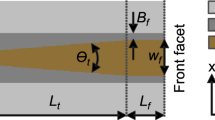Abstract
A state-of-the-art laser diode simulation tool has been used to investigate how phonon reflection at epitaxial interfaces impacts upon the performance of high-power 980 nm ridge waveguide lasers. Due to the inclusion of phonon reflection, a 0.5 K increase in quantum well temperature and a reduction in front facet output power of up to 0.6 mW is observed. The results demonstrate that whilst this effect is relatively small, a first order correction should be made to obtain accurate simulation results.
Similar content being viewed by others
References
Bream P.J., (2006). The impact of nonequilibrium gain in a spectral laser diode model. Opt. Quantum Electron. 38: 1019–1027
Capinski W.S., (1999). Thermal-conductivity measurements of GaAs/AlAs superlattices using a picosecond optical pump-and-probe technique. Phys. Rev. B 59: 8105–8113
Eckhause T.A., (2003). Electric-field-induced heating and energy relaxation in GaN. Phys. Lett. 82: 3035–3037
Filippov, K.A., et al.: The effect of the thermal boundary resistance on self-heating of AlGaN/GaN HFETs. Nitride Semicond. Res. 8 (2003)
Lichtenstein N., (2004). DPSSL and FL pump based on 980 nm-telecom pump laser technology: changing the industry 2nd conference on high-power diode laser technology an applications. Proc. SPIE 5336: 77–83
MacKenzie R., (2007a). The impact of hot-phonons on the performance of dilute nitride edge-emitting quantum well lasers. J. Phys. Conf. Ser. 92: 012068, 1–4
MacKenzie, R., et al.: An investigation of thermal boundary resistance in 1.3 μm edge-emitting dilute nitride quantum well laser diodes (Accepted for publication in pss-c Special issue on dilute nitride materials) (2007b)
Rodriguez D., (2002). Measurement of gain spectra, refractive index shift and line width enhancement factor in Al-free 980 nm lasers. SPIE 4646: 344–354
Selberherr, S.: Springer Analysis and Simulation of Heterostructure Devices. ISBN: 3211405372 (2004)
Stern M.S. (1998). Semivectorial polarised finite difference method for optical waveguides with arbitraty index profiles. IEE Proc. 135: 56–63
Swartz E.T. and Pohl R.O. (1989). Thermal boundary resistance. Rev. Mod. Phys. 61: 605–668
Wachutka G.K. (1990). Rigorous thermodynamic treatment of heat generation and conduction in semiconductor device modelling IEEE. Trans. Comput. Aided Des. 9: 1141–1149
Yang L., (2005). Numerical investigation of self-heating effects of oxide-confined vertical-cavity surface-emitting lasers. J. Quantum Electron. 41: 15–25
Author information
Authors and Affiliations
Corresponding author
Rights and permissions
About this article
Cite this article
Mackenzie, R., Lim, J.J., Bull, S. et al. Inclusion of thermal boundary resistance in the simulation of high-power 980 nm ridge waveguide lasers. Opt Quant Electron 40, 373–377 (2008). https://doi.org/10.1007/s11082-008-9191-z
Received:
Accepted:
Published:
Issue Date:
DOI: https://doi.org/10.1007/s11082-008-9191-z




